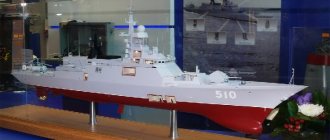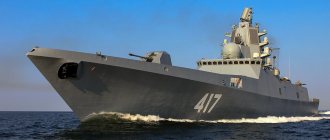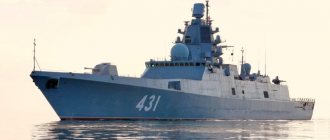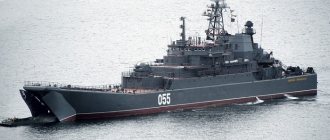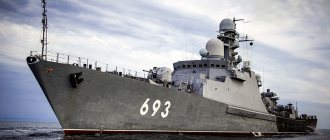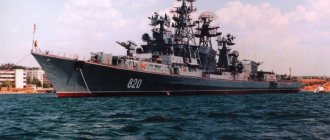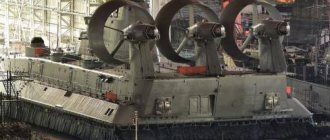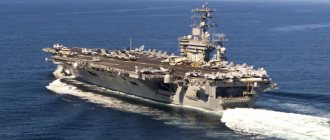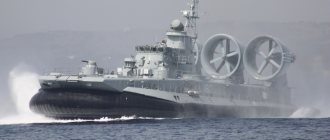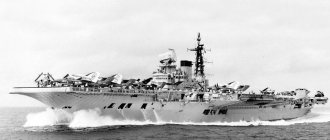Russia is resuming the construction of corvettes of projects 20380 and 20385. The parameters of the contract are now being clarified, sources in the military department told Izvestia. The ships will be produced taking into account the experience of previous operation and will be able to perform tasks in regions with difficult hydrographic and weather conditions. Initially, there were no plans to resume construction of these corvettes. For what reasons did the Navy change its decision and why the ship of the 20380 series will become one of the most massive in the fleet, military historian Dmitry Boltenkov looked into it.
Basic information about project 20385
Information about project 20385 in the media persistently claims that the corvettes of the project will not serve as part of the Northern Fleet, but will be used to equip the Pacific. These rumors have already been partially refuted by statements by the Supreme leadership of the Russian Navy, which claims that the Thundering will be part of the Northern Fleet. Whether this is true or not, time will tell. There is no reliable information yet about the second ship of the project, the cruiser Provorny. It is quite possible that he will serve in the Pacific Fleet.
Now Severnaya Verf is at an accelerated pace equipping the Gremyashchiy corvette, the launch of which is already close. This warship has become a representative of a new family of warships that are to be built as part of a special state program for the development of the navy. The basis for the creation of Project 20385 ships were the Project 20380 ships, which were developed at the Almaz Design Bureau.
Causes of the fire
It is too early to talk about the causes of the fire. There was no active work on the corvette on Friday. It is believed that the fire initially occurred in the control room of the main command post and on the tower-mast structure, from there the fire spread through the scaffolding to the fourth and fifth decks.
The first information about the fire began to appear around seven on Friday evening. At first it was reported that the fire engulfed the entire upper deck of the ship, which was located on the stocks, with an area of about 100 sq.m. Later, emergency services reported that the fire engulfed almost the entire warship, covering an area of 800 sq.m. .
Reasons that prompted the start of the development of project 20385
Since the top leadership of the Russian Navy already had experience in operating powerful warships of Project 20380, it was decided to develop improved corvettes based on this project, which would have more powerful and improved weapons on board. As a result of the creation of a new technical specification, Project 20385 was born, within the framework of which it was planned to build 5 ships of a new type.
The implementation of Project 20380 led to the appearance of 5 ships, 4 of which were transferred to the Northern Fleet. The ships of the new project 20385 should have been transferred to the Pacific Fleet, since there is currently only one corvette of project 20380 - “Perfect”. Project 20385 corvettes, like their predecessors, were to become second-rank vessels designed to perform combat missions of varying complexity in the near sea zone.
The new corvettes were supposed to have greater combat capabilities, as their weapons would be improved. Project 20385 ships will receive the following upgraded weapons:
- The Uran anti-ship defense system will be replaced with more advanced Kalibr-NK missiles. After this replacement, the new ships will be able to become a true universal unit, capable of not only operating against individual ships or their groups, but also solving other tactical tasks;
- The Redut air defense system will remain as a standard weapon, but it will receive additional launch cells. Now the ammunition load will be increased from 12 to 16 units.
It should be especially noted that equipping the corvette with Kalibr-NK cruise missiles will allow the ship to operate not only in the near sea zone. The flight range of cruise missiles is up to 2,000 km, which will enable new combat vessels to keep at gunpoint all significant military vessels located in the world's oceans. In addition, cruise missiles are no less effective at hitting ground targets.
Combat necessity or tribute to tradition
Patrol ships in the Russian fleet are not a new phenomenon. Russian sailors became acquainted with ships of this class during the First World War. These relatively small military vessels have become universal combat units, performing a huge amount of combat work. Abroad, such ships were classified as frigates and corvettes. The Russian Navy went its own way, creating a separate class of warships - patrol ships.
The appearance of these ships in the fleet was caused by an urgent need. Destroyers could also perform the functions of protecting the coast and sea raids, guarding convoys and countering small forces of the enemy fleet, but these ships were few in number. Building new destroyers in large numbers was an expensive proposition. It was considered that it would be more profitable to use similar vessels of a smaller displacement to perform the assigned tasks. Patrol ships should not be compared with destroyers in terms of combat and seaworthiness - these are completely different warships in terms of the nature of their use. Such ships must be universal and built en masse.
The economic factor also played a huge role. The construction of one patrol ship, frigate or corvette cost the treasury two or three times less than the construction of one destroyer. The Soviet Union was able to appreciate these advantages. In the 20s and 30s, in difficult economic conditions, the construction of patrol ships became the only opportunity for the USSR to increase the combat effectiveness of its fleet. In pre-war times, during the war years, patrol ships became the most massive combat vessels of the Soviet Navy. A similar principle of naval recruitment was followed in the USSR in the post-war period. The fleet was equipped with more powerful and advanced ships, due to which the class of patrol ships received a new development.
Unlike the first ships of this class, the Soviet patrol ships (SKR) became an order of magnitude stronger and more powerful. The Soviet Union is building ships that are not inferior to destroyers in terms of firepower and technical equipment. Abroad, Soviet patrol ships have long been classified as frigates, considering them full-fledged combat vessels. In the USSR they were used to building a lot and powerfully. Accordingly, the patrols became larger in size and received powerful weapons. This trend continued until the last days of the Soviet Union. It was planned to build project 11540 patrol ships for the fleet - large ocean-going warships. There was no need to say that the fleet needs TFR for the protection and defense of the coastal maritime zone. This niche in the Soviet Navy remained unfilled.
In Russia, which inherited a huge navy from the Soviet Union, it was necessary to solve the problem of creating ships in the near sea zone from scratch. Initially, Project 12441 ships were supposed to solve the problem, but it didn’t work out with Novik, the lead ship of the project. The project was rejected. It was decided to begin construction of the TFR in the form and in the version in which these ships should have been originally. In such conditions, Project 22380 was born, which provided for the construction of a small patrol ship to protect the near sea zone.
Tasks of the project ships
Although after the installation of cruise missiles the ships of Project 20385 will become real attack corvettes, according to the creators' plans they should become universal ships capable of solving a whole range of combat missions. If we compare the tactical and technical characteristics of the new warships, we can see that they are closer to the class of destroyers, which are the most versatile ships in the navy. The new ships of Project 20385 must solve the following combat missions:
- Search, detect and destroy enemy submarines. To do this, the corvette will be equipped with the most modern equipment and weapons in this field;
- Counteraction to all types of warships, which can be both in the coastal and far sea zones;
- Carry out combat duty along a given route;
- Conduct escort operations;
- Provide fire support for landing operations. It should be noted that after installing cruise missiles as standard weapons, the cruiser will receive such combat power that landing support will turn into clearing the territory before landing.
Project 20385 corvettes will be equipped with a KA-27 helicopter, whose tasks will include reconnaissance and rescue operations.
The first corvette of Project 20385 “Gremyashchiy” will become much less noticeable to radars than ships of Project 20380. This became possible thanks to the use of the latest polymer and composite materials in the construction of the ship’s hull. Also, the anti-location protection kit will become more modern.
At the initial stage of Project 20385, it was planned to produce about 20 ships of this class; the leadership of the navy repeatedly held conversations on this matter. As a result, the defense industry set up an entire production line to produce stamped parts for the new corvettes. New parts were made from composite and polymer materials. At the initial stage of development, two ships were laid down. The second corvette of Project 20385 was the Provorny, laid down in 2013. However, the economic situation has made its own adjustments, as a result of which at the present stage Project 20385 is represented by only two unfinished corvettes.
Modifications
- 20380P and 20383 - projects of border patrol ships (not implemented); - 20382 - export version, capable of performing tasks in the far sea zone (not implemented); - 20385 - modernization of the basic project with enhanced anti-aircraft missile and anti-ship weapons. Initially, it was planned to install diesel units from the German company MTU Friedrichshafen on ships of this modification, but after the company refused to supply engines due to the sanctions imposed against the Russian Federation in 2014, it was decided to use Russian-made units. - 20386 - project of a new generation corvette with modular weapons, a superstructure made of composite materials, reduced radar signature compared to its predecessors, increased displacement (3 thousand 400 tons) and cruising range (9 thousand 260 km), reduced crew size (80 people ).
Main differences
As for the materials from which the first ship of Project 20385 was built, they differ significantly from the materials of the ships of Project 20380. The Gremyashchiy corvette was built using a large number of composite materials that were developed by domestic enterprises. A special role in this was played by FSUE Prometey, whose specialists not only developed, but also created technologies for the production of polymer-composite materials suitable for shipbuilding.
Due to the fact that the superstructure of the Gremyashchiy corvette is made of non-flammable plastic, it was possible to significantly reduce the overall weight of the warship. This made it possible to increase the speed of the corvette and place heavier weapons on board.
When developing the new corvette, the designers took into account the comments of the military, who complained about the insufficient seaworthiness of the Project 20380 ships, so the Gremyashchiy will have better resistance to pitching. The corvette will be able to carry out its combat missions in sea conditions of up to 5 points. The survivability of the ship will also be significantly increased due to a decrease in the radar background, which will help the ship remain unnoticed by enemy radars, increasing the chances of the Thundering One to deliver a surprise attack on ships or coastal fortifications.
As for the power plant of the lead ship of Project 20385, it is currently two powerful 16D49 diesel engines, developing 6,000 l/s each. Initially, it was planned to equip the ships of the project with German engines, but since the situation in the political arena has become tense in recent years, it was decided to abandon the foreign-made engine.
The urgent task was to find or develop not only a new engine, but also other ship mechanisms that were planned to be imported. The domestic defense industry coped with this task with honor. Currently, domestic engines have been adapted for warships and have successfully passed a number of tests.
Subject to restoration
On December 18-19, after the fire fighting was completed, Severnaya Verf specialists conducted an initial inspection of the Provorny. They came to a preliminary conclusion - the ship must be restored. The company reported this on its official website.
“... thanks to the installed fireproof insulation between the superstructure and the deck, the ship’s hull was not damaged. The superstructure must be dismantled. There was no equipment in the superstructure... negotiations are underway on the construction of a new superstructure,” the communiqué says.
The company clarified that to prevent freezing of the water that got into the holds during firefighting, heating and electricity were turned on. About a hundred workers pumped out water, dried surfaces and cleaned the premises from the consequences of the fire. A commission consisting of representatives of Severnaya Verf and USC will begin its work to assess the damage. It is too early to speculate about the causes of the fire. This commission will need several weeks to study all the circumstances and determine the causes of the emergency.
Technical parameters of the corvette "Gremyashchiy"
The first corvette of Project 20385 “Gremyashchiy” has the following tactical and technical characteristics:
- The hull length is 104 meters;
- Width – 13 meters;
- Displacement 2,200 tons;
- The ship can travel a distance of up to 5,600 km. In this case, the maximum speed is 27 knots;
- Full autonomy of the ship can reach 15 days;
- The ship's crew is 99 people.
The corvette's armament consists of the following systems:
- The Kalibr-NK missile system, which is capable of effectively hitting both surface and ground targets at a distance of up to 2,000 km. Thanks to the cruise missiles placed on board the cruiser, it is capable of acting as an attack ship;
- Improved air defense system "Redut";
- 100-mm artillery mount A-190-01;
- Two AK-630-M anti-aircraft machine guns;
- Advanced anti-submarine weapons "Package".
In addition, the KA-27 helicopter, which has bomb and torpedo weapons on board, can also be included in the armament of the Gremyashchiy corvette. The ship's crew will be armed with Igla MANPADS.
Bottom line
The Project 20385 corvette, the characteristics of which are given above, has the most modern weapons and a multifunctional focus. As part of this event, the construction of only one of the representatives (“Thundering”) continues. The remaining vessels are being developed according to an updated design. This is due to the rise in cost of the ship, which is not always justified by the presence of various types of heavy weapons. The developers, despite the delay in replacing foreign power plants with domestic analogues, say that all planned work is being carried out according to the planned schedule.
Project ship weapon systems
The lead ship of the project, like its younger brother, the corvette Provorny, should be equipped with two Kalibr-NK universal combat missile systems with 8 cruise missiles on board. The basis of air defense is the well-known Redut missile launcher. The corvettes will also have artillery weapons. The main caliber is represented by a 100 mm automatic gun mount A-190-01. In addition to it, the ship's close-range firepower is provided by two 30 mm AK-630M assault rifles. The ship's crew had at their disposal the Igla MANPADS.
The ships must be equipped with powerful torpedo weapons capable of effectively fighting both enemy surface ships and submarines. All weapons on the ship were controlled by the automated Puma system. For close combat, the corvette had machine gun turrets and two grenade launchers.
Corvettes are equipped not only with offensive and defensive weapons. A special place in ensuring the survivability of a vessel is occupied by radar and navigation equipment. The corvettes have the well-known Sigma BIUS. To quickly identify the enemy at sea and in the air, the corvettes are equipped with the Fourke-2 station. The fire control system works in tandem with the Monument A guidance system. The Zarya and Minotaur tracking and detection stations are responsible for the condition of the underwater horizon.
Thanks to such a wealth of radar, hydroacoustic and navigation equipment, Project 20385 corvettes have high survivability. Corvettes can detect ships of a potential enemy at long distances, while remaining outside the detection zone.
Tales of Corvettes of the 20380 family
Home » Alternative History » Alternative shipbuilding - Fleets that never existed » Tales of corvettes of the 20380 family
Editor's choice Alternative shipbuilding - Fleets that never existed
Dmitry Yu 09/12/2020 3649
21
in Favoritesin Favoritesfrom Favorites 9
Tales of Corvettes of the 20380 family
Isn’t it stupid for us, brothers, to start with old words about difficult stories about corvettes of Project 20380 and similar projects?
Content:
The Tale of Corvette 20380
In a certain kingdom, in a certain state, there lived a navy, and it began to need new surface ships.
Not in the city of Bogdan and not in the village of Selifan, not for long, but not for short, they built and built, and finally built, a Project 20380 corvette.
And there was, my brothers, the corvette of Project 20380 in 2001, when the design was completed and construction began, the most miracle ship.
In front of it was a new universal (that is, against surface, ground and air adversaries) A-190 automatic cannon with a caliber of 100 mm. Much lighter than the previous universal naval cannon of the same caliber AK-100, but no worse in any way, and, on the contrary, in addition, it is also faster-firing than its ancestor.
Against surface adversaries, the corvette received two four-tube launchers of Uran anti-ship missiles, which were all good, except for one thing: they could not be used against any other target - neither against a submarine, nor against a land enemy. This missile can only be fired at a surface target.
For defense against airborne opponents, the designers planned to install on the Project 20380 corvette the new Redut anti-aircraft missile system (SAM) on 12 vertical launch cells and place there either 12 9M96E medium-range anti-aircraft guided missiles (SAMs) or 48 9M100 short-range SAMs ( 4 pieces in one cell), or some combination thereof. For example, you can fit in twelve cells 6 medium-range 9M96E missiles and another 24 short-range 9M100 missiles. This solution would allow the Project 20380 corvette to fight airborne adversaries both at ranges of up to 40...50 km using the 9M96E missile defense system, and at ranges of up to 15 km using the 9M100 missile defense system.
True, by 2001, the suppliers of the Redut air defense system did not have time to present it in kind to the clear eyes of the builders of the lead ship, and, having apologised, they offered to place the Kortik-M air defense module on the tank of the lead ship Steregushchiy. “Kortik-M” on the corvette “Steregushchy” has two 30-mm six-barreled anti-aircraft guns AO-18K, and has no missiles at all, but in order to confuse those who would think of attacking the lead ship of Project 20380 from the air, the module was called “Kortik-M” "by the letter combination ZRAK, which stands for, if Wikipedia is to be believed, as “anti-aircraft missile and artillery complex”:
A fault confessed is half redressed. They installed this same “Kortik-M” on the lead corvette “Steregushchy”, so that the front hemisphere was protected by both a 100-mm cannon and 30-mm machine guns, but they were not protected by any anti-aircraft missiles at all.
Well, starting with the second corvette of Project 20380, when the suppliers were honored to present the promised Redut air defense system to the corvette builders three years ago, it was immediately installed in the first production corvette named “Savvy” and then in all corvettes of the series, exactly in the place where the Kortik-M module was located on the lead ship.
The corvette's armament complex was supplemented with two time-tested six-barreled 30-mm AK-630M artillery mounts located on the side of the helicopter hangar.
To counter underwater enemies in the Project 20380 corvette, for the first time in domestic naval shipbuilding, designers used two new four-tube 324-mm torpedo tubes “Paket-NK”, which can be equipped with both anti-submarine and anti-torpedo torpedoes. In truth, foreigners have been using three-tube 324-mm torpedo tubes against submarines since the 60s of the twentieth century and are still using three-tube 324-mm torpedo tubes to arm their surface ships, and only Soviet specialists, in defiance of them, used powerful 533-mm torpedo tubes (and to this day They are nostalgic for them, I don’t understand why).
And, to top it all off, like the icing on the cake, the corvette received not only a helipad, but also a spacious shed for a Ka-27 type helicopter, a tank for storing a fair amount of helicopter fuel, as well as a ship’s boat and an RIB boat.
As for the main power plant (GEM), the project 20380 corvette is designed with four diesel engines, each with a power of 6,000 hp, therefore, a total power of 24,000 hp. This kind of power plant device allowed the Project 20380 corvette to boast of efficiency, which domestic ships had not boasted of at all before. However, the total power for a warship of such displacement was not great, and, as a result, the maximum speed was only 26.5 knots, if you look at the Wikipedia page.
PROJECT EVALUATION
As soon as the Russian people became aware of the Project 20380 corvette, spiteful critics immediately formed among them and barked that, they say:
- the A-190 cannon on the corvette does not fire in bursts;
- The Redut air defense system fires regularly, but always misses the target;
- anti-ship missiles “Uran” fire as required and hit the target, but fly quietly and not far away;
- if the onboard helicopter finds an enemy submarine outside the affected area of the Paket-NK anti-submarine defense system, then the corvette will have nothing to hit it with;
- diesel engines break down every day.
Yes: it will be easier to theorize from the couch than to debug complex technical complexes and systems in a stormy sea. Soon the fairy tale is told, but not soon the deed is done, but, nevertheless:
- The A-190 gun was set up the fastest and began to chirp as expected;
- The Redut air defense system little by little learned to hit the target;
- in 2009, a new modification of the missile for the Uran complex was presented, named X-35UE, with a firing range increased to 260 kilometers, which, although it flies no faster than sound, is low and you can’t even see it;
- against submarines, surface sailors learned to fight as a team (with a gang of 2-3 corvettes), and at the same time one of the onboard helicopters of the group was armed with torpedoes, and the rest of the helicopters conducted a search;
- and even by direct providence of the Lord they adjusted the diesel engine so that the corvette could go on a sea voyage without a tug.
And so the Project 20380 corvette became such a wonderful warship, useful for every need.
“And you know my corvettes: they are worn under the pipes, they are cherished under the helmets, and the end is a copy of the rearing; Lead them to the paths, the circles they know, their bows are tense, their crowns are open, their sabers are sharpened.”
What can be translated into modern Russian in the translation by Igor Zabolotsky as follows:
- And the glorious corvettes are serviceable knights: Born under pipes, Grew up under radars, Grew up like warriors, Fed from the end of a spear. All the paths are known to them, All the seas are known to them, Their guns are tuned, Their cells are open, The complexes are all accurate, The contacts are gilded.
Note: here the poetic translation of a fragment of “The Tale of Igor’s Campaign” from Igor Zabolotsky is spoiled by insertions from the author.
This is a saying, not a fairy tale, a fairy tale will come.
The Tale of Corvette 20385
In 2012, and then in 2013, two corvettes were laid down in many ways similar to Project 20380, but a modernized project. This project received number 20385.
They wanted the best: to replace the highly specialized anti-ship missile system "Uran" with 8 missiles with the universal missile system "Caliber" with 8 missiles (there are various anti-ship missiles of enormous speed and range, and anti-submarine, and against ground targets), and even The ammunition load of the Redut air defense system was increased from 12 to 16 cells, and a new Zaslon radar system was installed so that the enemy air ship could see further, better, and could fire at many people at once.
But it turned out as always: when the customers agreed on the project, they had fun, but when they did the math, they shed tears. So, they say, something turned out to be expensive. We need something cheaper.
This is a saying, not a fairy tale, a fairy tale will come.
The Tale of Corvette 20386
OK. If it’s cheaper, we can do it, the designers said, and they designed a Project 20386 corvette that can’t be described with words or pens. And when they moved from pictures to action and began to build it, it turned out that it was not cheaper at all, but quite the opposite.
They build and build, but it’s not clear about the weapons. Some kind of modular, but what that means is not clear. There’s definitely a cannon, it looks like it’s 100-mm caliber, and there’s some kind of anti-aircraft missile system on the tank, and it looks like there’s an old familiar Uran anti-ship missile on board, but all this is somehow not specific.
The main power plant went to a completely different steppe: two M90FR gas turbine engines with a power of 27,500 hp each. developed by NPO Saturn, plus two main electric motors ADR-1600-V with a power of 2200 hp each. developed by JSC Zvezda. In a word, we are not talking about fuel economy, but we are talking about a high maximum speed, as it should be for warships. Moreover, they added electric motion to the side.
In a word, it turned out like American littoral ships - beautiful, expensive and incomprehensible to the common mind.
Or maybe that’s how it should be: why should a simple mind think about this? Maybe not a trace!
This is a saying, not a fairy tale, a fairy tale will come.
The Tale of the Corvette 20380M1 So, we are finishing the tale, we even dragged it out a little, it’s time for the fairy tale to begin.
In 2022, they decided to build a dozen more corvettes, and they say: project 20385 is too expensive, and project 20386 is such that you can barely spit, not to say a bad word out loud. Well, it’s somehow strange to build project 20380 20 years after the completion of the design.
The designers thought and thought, and came up with it. Therefore, it is necessary to hire a good fellow for the job and entrust the job to him. Hiring is a simple matter. And he tells them:
- Kind people! Instead of “Uran”, it is necessary to install the “Caliber” missile system on a corvette, then everyone understands, except, of course, their wives and small children. It is clear to everyone that if they stuff the Kalibr missile system into the small Karakurt missile ships with a displacement of 800 tons, then it is in no way possible to leave a ship of two thousand tons without such weapons. Especially because the miracle missile “Zircon” has recently been invented, which can be inserted into the cell of the UKSK “Caliber”. And it flies so fast that it will be impossible for the enemy to defend against it. They also came up with the Caliber-M rocket, which does not fly as fast as the Zircon, but very far.
“It started well, keep going,” the designers answer him.
— The high cost of the corvette 20385 is mainly due to the new radar device and the increased number of cells of the Redut air defense system. So leave a cheap radar of some kind and the Redut air defense system with twelve cells, like in serial corvettes. But if you increase the length of the hull of a Project 20380 corvette by 10 meters, it will just be the same length as the American destroyers Fletcher of World War II. The ships were beautiful, everyone was jealous of them. Well, ship steel is not very expensive. But if you increase the length, it will be a shame to remain with four engines of six thousand horses, it will not be enough. Let diesel engines remain for economical propulsion, and use two M70FRU gas turbine engines with a power of 12,000/14,000 hp as afterburners. With. (powers are given for nominal and maximum modes). They are small in size and will fit into engine rooms without difficulty. The total power of the power plant will be 2x6000+2x12000/14000=36000/40000 hp. Both economical and fast.
- Why, good fellow, increase the length of the body? - they ask him.
— Nowadays it is fashionable not to place boats openly, but to hide them behind the ports. So it would be better to place a ship’s boat with an RIB-boat between the pipe and the front mast, where the Uran anti-ship missile system used to be, just to move this part of the ship a little further (so that nine-meter unmanned boats can easily fit there when their suppliers finally make them ), and on the forecastle, if the ship’s hull is extended, the Caliber UKSK will be placed, including two modules of 8 cells each, after the Redut air defense system.
— What, after the boats are removed, will we expand the helicopter hangar?
— No, it’s better to put on the side of the helicopter hangar, instead of the old six-barreled AK-630M cannons, new “Broadsword” SAM guns with guns and missiles, two of them, like on a Project 22350 frigate. They say the Broadsword has longer barrels, and In addition, the guidance is optical-electronic, so it will be more resistant to interference than the AK-630M, and there are missiles.
“Well, draw,” the designers say to the good fellow.
He drew it, you’ll erase it:
The designers took the 20380M1 project to the Customer, and he told them:
-Oh, you are a goy, good fellow! Apparently you conceived a ship out of great intelligence, but what you came up with was utter nonsense. Why do we need a pair of broadsword ZRAKs located on the side of the helicopter hangar on a 13-meter-wide corvette, if we couldn’t place them on the 16-meter-wide Project 22350 frigate and had to install it without missiles, only in the ZAK version? You yourself drew the “Broadsword” ZRAK, the paper will endure anything, but do you know what its under-deck volume is? You don't know, because it's a secret.
-What resolution, then, would you like to present, Your Honor?
-Bring back, scoundrel, the rear six-barreled 30-mm AK-630M assault rifles. We didn’t invent this gun, and it’s not up to us to remove it from service! All the same, you don’t have below-deck space for the Broadsword - either with missiles or without missiles.
The good fellow began to spin, his face turned pale, and he began to cry with burning tears.
The Customer felt sorry for him, after all, tea is Russian people.
- Well, he says, good fellow, don’t fight, come in if you need anything. And the best ship in the world was the Project 1135 patrol ship, on which I served during it. Look there, it will be of great benefit to your mind.
The Tale of Corvette 20380M2
A kind word was said to the good fellow by the Customer for the sake of politeness only, and the good fellow the next day comes again with a blue eye.
“Here,” he says, “I returned the 30-mm AK-630M cannons dear to your heart to their original places near the helicopter hangar, and instead of the boats I placed the Gibka guided weapon systems, in their maximum version (on one installation there are 12 Verba missile defense systems). This combination of AK-630M + “Gibka” will protect the rear hemisphere from the air adversary, and it is completely undemanding to the below-deck space.
- Oh how. Have you looked at project 1135?
— As the main power plant of the corvette, following the example of the Project 1135 patrol ship, I installed four M70FRU gas turbine engines with a power of 12000/14000 hp. With. (powers are given for nominal and maximum modes). They are small in size and will fit into engine rooms without difficulty. The total power of the power plant will be 4x12000/14000=48000/56000 hp. It will be a fast and reliable ship, although not as economical as Project 20380.
“Well,” says the Customer in a human voice, “the matter doesn’t look promising, let’s go and report to the Admiral.” A mind is good, but two are better.
They brought it to the Admiral, and he said to them:
- It looks a bit large, the Far Eastern shipbuilder will not be able to handle such a hull length, they need less. About weapons, I’ll say this: haven’t you seen the modernization project for the Marshal Shaposhnikov BOD, you idiots? Both “Uranus” and “Caliber” fit there. This is not easy. "Uran" is inexpensive, flies low, and hits reliably. If you stop producing it, and then you need to restore production again, we’ll bite off your elbows. Such equipment always needs to be mass-produced, smoothly, therefore, without jerks, and if we stop ordering, the factories will send the workers into idle time, those workers will scatter, the machines will be handed over for metal, and if you put it all back together later, it will not be soon and with at great expense. But “Caliber” is also good, the truth is yours, it’s not advisable to sail on a warship in the blue sea without it. In a word, do it like they did on the modernized BOD Marshal Shaposhnikov. Regarding nine-meter boats, I will say that this is not a matter of principle for a corvette. If they would fit on a corvette, it would be good, but if they didn’t, well, the dog would go with them. An old boat with a RIB will do, as long as they don't sink. Return diesel to the power plant - distances are long in the Pacific Ocean, fuel economy is the most important thing there.
The Tale of Corvette 20380M3
They drew it as stated: both “Uranus” and “Caliber” fit, although, of course, the BOD “Marshal Shaposhnikov” has more “Caliber” cells - so the displacement is ocean-going. The length of 107.5 meters does not seem to be too long. Grace:
The picture was brought to the Grand Voivode.
“Eh,” the Big Voivode tells them, “your parsunka is good, but I already signed an agreement to build project 20380 corvettes, eight of them, and two more project 20385 corvettes. It’s too late, you guys realized it.”
- What should we do tapericha? - asks the Customer.
And then the big voivode uttered his golden word, mixed with tears, and said:
- Oh, sons, I did not know such evil! I'm tired of designing yours, no matter how you draw it, it turns out worse and worse. That’s why I decided to build what had already been designed. However, I see that your pencils are itching, and you need to sharpen them on paper. If so, draw me a drawing so that I don’t move a step away from the Corvette 20380 project, but still improve it.
The Tale of Corvette 20380M4
The good fellow became more saddened than before, and then asked his wife the Frog Princess: “I was ordered by the Great Voivode to draw such a drawing so that I would not deviate a single step from the project of corvette 20380, but still improve it.”
The frog princess of the good fellow asks:
— And if a Project 20380 corvette fights against, for example, an enemy missile destroyer, will it have to fire eight missiles in one salvo at the adversary, or four?
- Well, I’m not a military man, but in my opinion, shooting with four will be enough. If he detects it in a timely manner, he will shoot down both four and eight. And if he doesn’t find it, then four will be enough.
— And a helicopter, if it has flown off to sniff out submarines, will it look for them from one side of the corvette, or will it begin to jump like a flea: it will either jump from the starboard side to the left side, or, on the contrary, from left to starboard?
- Yes, it seems that a helicopter is conducting a search on one side of the corvette.
- Well, just draw that instead of one of the four-tube missile launchers of the Uran anti-ship missile system, there is one four-tube launcher of the RPK-9 Medvedka anti-submarine missile system.
The maximum range of both the Medvedka and the Packet-NK is 20 kilometers, if Wikipedia does not lie. However, a rocket flies faster than a torpedo floats. The opposing submarine won't have much time to take countermeasures. Here your anti-submarine firepower will increase, but your anti-ship firepower will remain decent, and the drawing will not change one step.
And you also dreamed of using diesel engines for economic propulsion, and gas turbine engines for afterburner. Well, draw it as you dreamed. What if the Big Voivode likes it?
Well, if the Americans put short-range missile launchers on top of the helicopter hangar on their littoral ships, you should do the same.
- Well, we don’t have such installations! - the good fellow answered Zhana
- What about your “Bending”? Put it, why regret it?
So the good fellow drew a new picture:
That new picture went into the folder separately, but what is written on the folder, whether to execute or pardon, is a great mystery. That’s the end of the fairy tale, and those who listened and looked at the pictures - well done!
The fairy tale is a lie, but there is a hint in it, a lesson for good fellows.
Afterword
The text uses quotes from the Lay of Igor's Campaign, both in the original text and in the translation by Igor Zabolotsky, sometimes spoiled by the author's insertions. These fragments of the tale are in italics
According to the Author, both the serial corvettes of Project 20380 and the serial corvettes of Project 20385 are excellent warships, not only not inferior to their foreign classmates (the German corvette of the Braunschweig type, the American littoral ships of the Freedom and Independence types, the Chinese corvette of the 056 type), but also superior to them in armament and versatility.
Regarding the advantages and disadvantages of certain shipborne radar systems (Furke-2, Mineral-M, Zaslon, Positive, etc.) and in general regarding shipborne electronic weapons, the Author has no opinion.
The Author understands even less about the characteristics and models of hydroacoustic systems and complexes.
As for short-range air defense, Russian industry probably should stop looking for its original way of building bulky anti-aircraft missile and artillery systems with huge below-deck volumes, and it would be better to make a light launcher for short-range missiles instead of the Gibka KUV, like everyone else on the planet does:
Such an installation on the roof of the hangar would increase the security of Russian ships in the near air defense zone.
FOLLOWING THE COMMENTARY OF VLADIMIR SHATILOV
In his commentary, our colleague Vladimir Shatilov made a number of valuable comments and suggestions on the above drawings.
For example, about the possibility of the Amur Shipyard to build hulls 114.5 meters long and about the desirability of just such a size for the domestic fleet.
I agreed with a number of Vladimir’s proposals, but rejected others. The result of joint creativity is a drawing of version 20380M5:
And for a snack, option number 6
In project 20380M6, in continuation of the design solution of project 20385, two modules of 4 cells of the Redut air defense system appeared at the stern, in addition to a module of 12 cells on the tank. In total, therefore, the ammunition load of the Redut air defense system includes 20 cells for accommodating different types of missiles (medium-range missiles 9M96E and short-range missiles 9M100, 4 pieces in one cell).
To reliably control the Redut air defense missiles, a second Puma radar appeared in the rear hemisphere.
As before, there is no Integrated Radar Radar Tower “Zaslon” here in order to reduce the cost of the project.
Project 20380M7 corvette
Here we see an Improved Alternative Heavy Corvette with dimensions of 114.5x13 meters:
3 modules each with 8 cells of the Redut air defense system, the firing of the missile defense system is controlled by two Puma radars - 24 cells in total
ZAK AK-630 are placed more successfully than in Project 20380: they have moved as close to the stern as possible, which makes it possible to reduce the dead zone in the rear hemisphere. This will require a slightly different position for the Package-NK, boats and boats:
Out of respect for my colleague Vladimir Shatilov, I am attaching a drawing of his project based on my sketches 20380M2, 20380M3, 20380M7
Construction and commissioning
The lead ship, the corvette Gremyashchiy, was laid down in the winter of 2012. Following this, a year and a half later, in the summer of 2013, the first production ship, the corvette “Provorny”, was laid down. The basis for the start of construction was the state defense order and contract. In accordance with the terms of the contract at Severnaya Verf, it was planned to lay down and launch 8 corvettes of Project 20385 by 2020. To date, construction is limited to two ships of this class. Discussions about laying down two more ships of the same type in addition to those already under construction end in the corridors of the Main Naval Headquarters and the Ministry of Defense of the Russian Federation. Most likely, further construction of ships of this class will be carried out on the basis of a basic design, which is entirely dependent on domestic equipment, parts and mechanisms.
Both vessels will today be completed by domestic enterprises, which will have to supply all the necessary components, assemblies and equipment instead of foreign analogues. It will not be possible to achieve a high-quality and equivalent replacement, however, according to military experts, such technological innovations during construction cannot significantly reduce the design tactical and technical characteristics of the ships.
To date, the active construction phase is carried out only on the lead ship. The corvette “Provorny” will be returned to the cradle of Project 20380 to be equipped with domestic components and assemblies. This, in turn, leads to a significant reduction in the cost of building ships and will make it possible to meet the deadlines for commissioning the ship into service in the domestic fleet.
Peculiarities
A very important difference between the ship in question is the presence of an optocoupler-type mast, which serves to control radar devices and increases the ability to detect enemy targets, and also helps to strengthen the combat caravan, guaranteeing the escort and identification of ships and aircraft. A significant role in this is played by the radar and control unit of the Puma type.
Judging by the commentary of the leading engineer of the Almaz central design bureau, K. Golubev, development in terms of new naval ship construction is also being carried out according to an improved program under the index 20386. The project is focused on the maximum provision of domestic weapons, although the details of the construction still remain secret.
As stated by Deputy Minister of Defense of Russia Yu. Borisov, by 2022 it is planned to produce at least 16 corvettes of the class in question. The main production facilities are concentrated at the shipyard in St. Petersburg and the Amur Shipbuilding Plant.
Experts think that the main problem in the construction of such ships is the compatibility of the latest weapons in large quantities and the cost of the final version. Designers continue to work to bring this figure to the optimal level.
